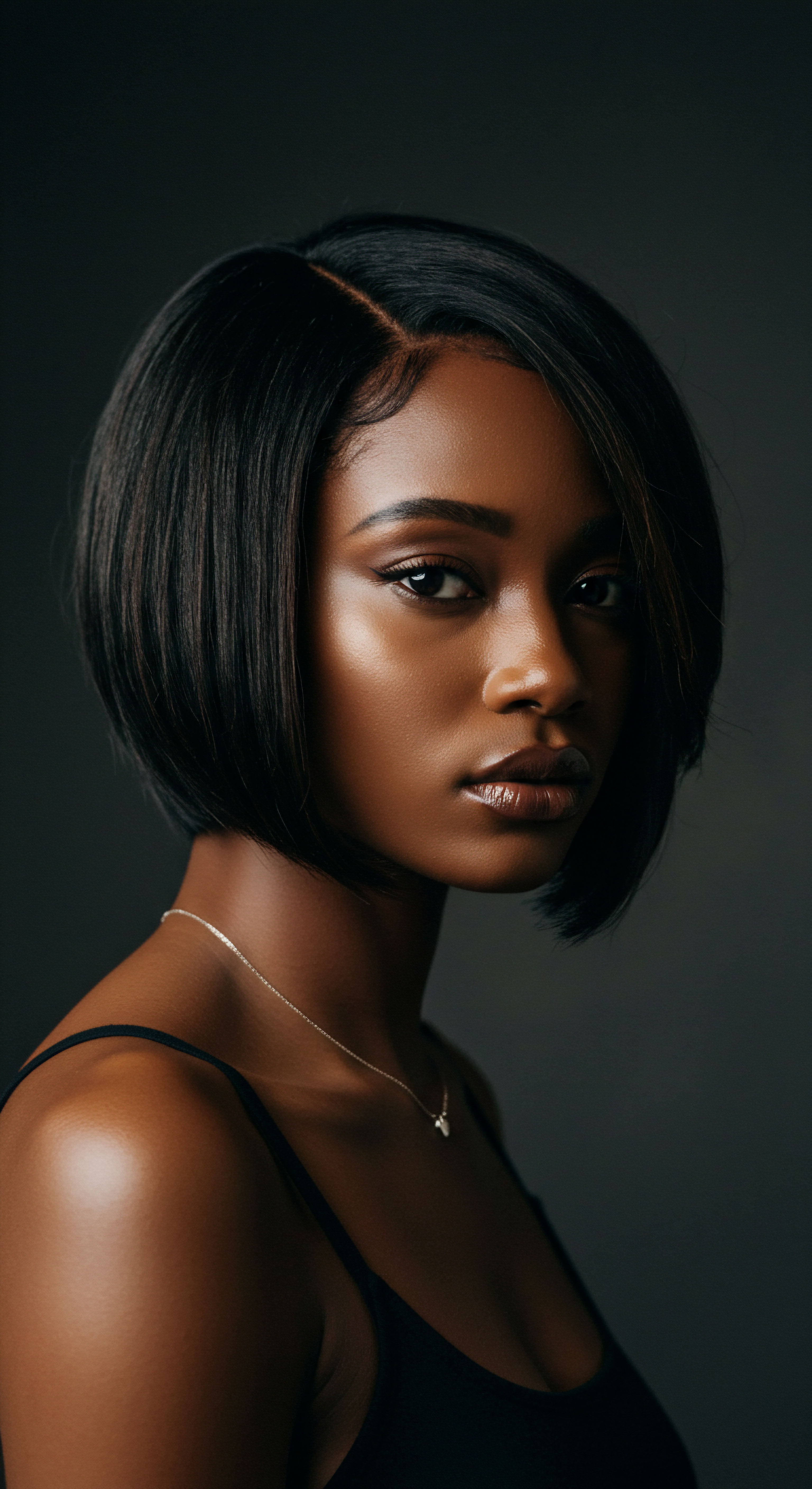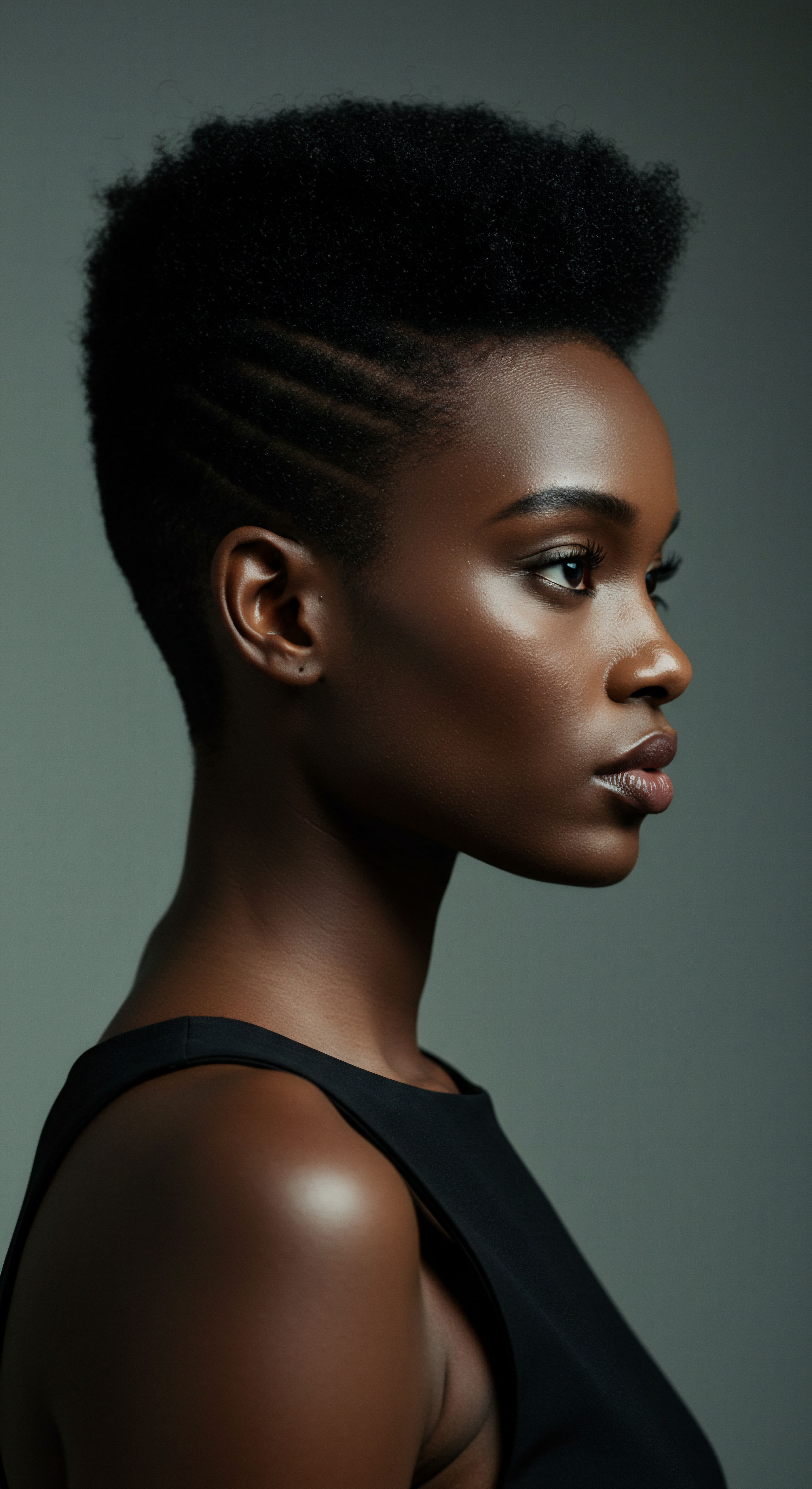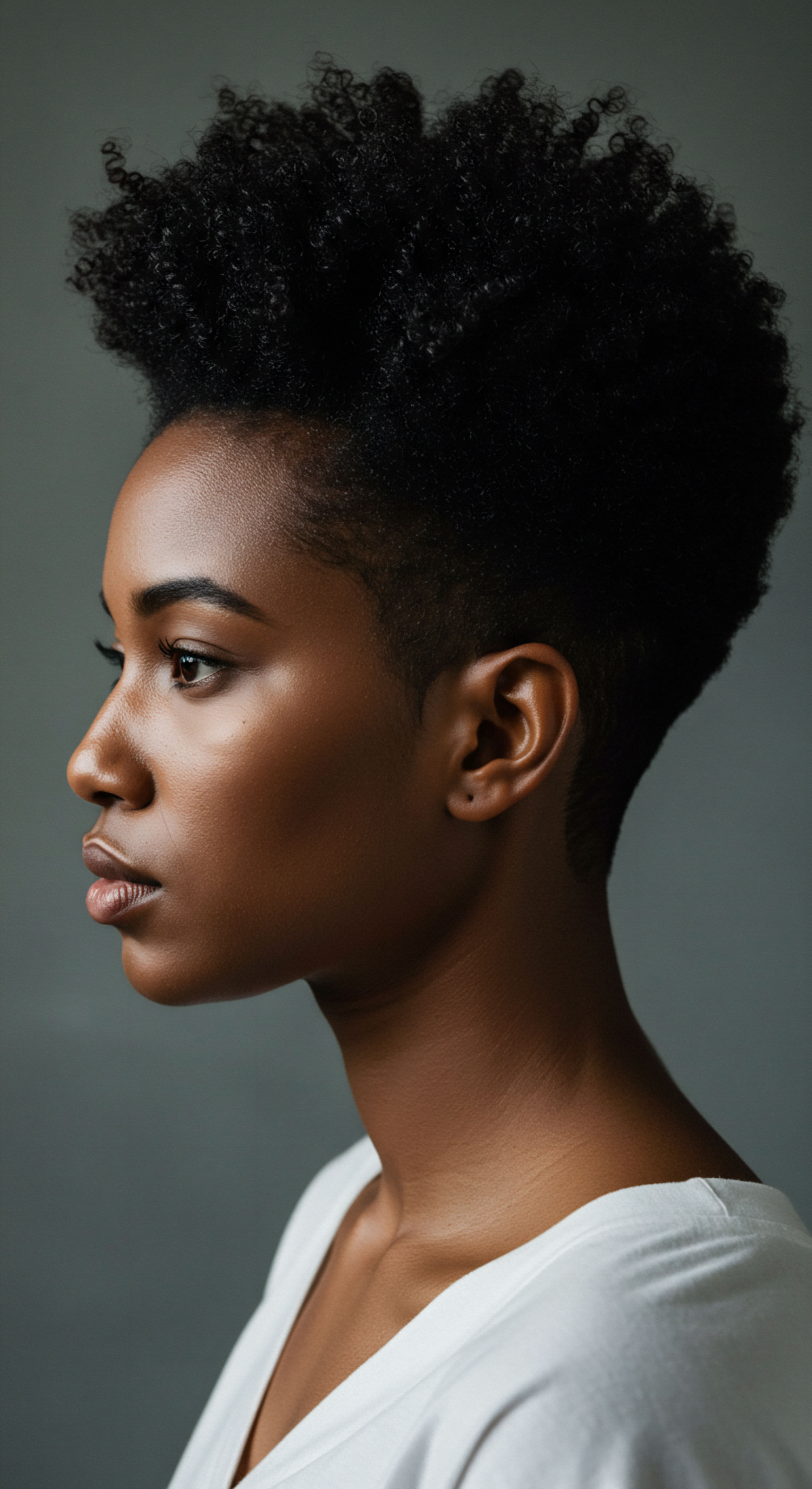
Roots
The quiet rustle of fabric, the gentle fall of a silk scarf, the proud statement of a patterned wrap – these moments, seemingly simple, hold within them echoes of centuries, stories whispered across generations, and the resilient spirit of textured hair. We often see head coverings as mere accessories, yet their presence in the care and cultural expression of textured hair runs far deeper, forming a profound connection to heritage, protection, and identity. This journey into their origins unearths a rich soil of meaning, inviting us to see beyond the visible and into the soul of a practice that continues to shape lives today.

Ancient African Adornment and Protection
Long before the forced displacement of people from Africa, head coverings held a revered place in various African societies. These were not simply practical garments; they were visual lexicons, communicating a wealth of information about the wearer. A head wrap could speak of one’s marital status, age, social standing, religious affiliation, or even tribal lineage. In many communities, the head itself was considered the most sacred part of the body, the seat of spirituality and wisdom.
Protecting it, therefore, carried immense spiritual weight. This belief system meant that adorning the head was an act of reverence, a way to honor the divine connection believed to reside there.
The materials used were as varied as the cultures themselves, ranging from finely spun cottons to luxurious silks, each chosen for its symbolic meaning and protective qualities. Beyond their spiritual significance, head coverings served a practical purpose in safeguarding hair from the elements. The sun’s intense rays, dust, and environmental aggressors could all take a toll on delicate textured strands. A wrap offered a shield, preserving moisture and preventing tangles, a physical act of care deeply intertwined with cultural practice.
Head coverings in ancient African societies served as intricate forms of communication, signaling status, spirituality, and protecting textured hair from environmental elements.
For example, among the Yoruba people of Nigeria, hair was considered as important as the head itself, with care for both believed to bring good fortune. Early practices like “Irun Kiko,” or African hair threading, used natural elements and techniques to keep hair healthy, often covered by wraps for ceremonial or protective reasons. This historical context reveals a continuum of care and adornment where head coverings were not an afterthought but an integral part of a holistic approach to hair and self.

Early Materials and Methods
- Cotton ❉ Readily available and breathable, cotton served as a foundational material for everyday wraps, offering comfort and basic protection.
- Silk ❉ Reserved for special occasions or those of higher status, silk provided a softer, more luxurious covering, reducing friction on hair.
- Adornments ❉ Shells, beads, and precious metals were often incorporated into wraps, further enhancing their communicative and aesthetic value.
The methods of tying and draping also varied widely, with each fold and knot potentially carrying specific meaning. These techniques were passed down through generations, becoming an integral part of a community’s visual heritage. The artistry involved in crafting and wearing these coverings was a testament to the cultural value placed on hair and its presentation.

Ritual
As we move from the foundational origins, a natural curiosity arises ❉ how did these ancient practices transform into the daily rituals and cherished habits of today? The transition from historical context to present-day application reflects a journey of adaptation, resilience, and reclamation. Head coverings, once solely symbols of status or spiritual connection, evolved to become essential tools in the practical care of textured hair, particularly in the face of new challenges and changing environments. This section explores the tangible practices that bring the cultural background of head coverings into our present understanding of hair wellness.

Head Coverings and the Transatlantic Passage
The transatlantic slave trade profoundly altered the significance and practice of head coverings for people of African descent. Stripped of their ancestral adornments and traditional hair care tools upon forced arrival in the Americas, enslaved African women often found their hair forcibly shaved or neglected due to brutal labor conditions. In this harrowing new reality, head coverings, often simple pieces of rough fabric, became a symbol of subjugation and dehumanization. Slave masters mandated their wear, not for protection or adornment, but to obscure African hairstyles deemed “unattractive and offensive” by European standards.
Yet, even within this oppression, a quiet act of defiance began to surface. What was imposed as a mark of servitude slowly, subtly, became a tool of survival and resistance. These coverings shielded delicate hair from the harsh sun and physical toll of field work, preventing breakage and maintaining some semblance of health.
Beyond mere physical protection, the head wrap became a clandestine canvas for identity. Within its folds, women would hide small treasures, messages, or even seeds, transforming a symbol of bondage into a private sanctuary.
From ancient adornment to forced concealment during slavery, head coverings underwent a profound transformation, yet retained their essential role in hair care and cultural expression.
The transformation of the head wrap from a mandated uniform to a statement of personal and collective identity is a testament to the resilience of those who wore them. It speaks to a profound human need to preserve selfhood even under the most trying circumstances. This historical period, though painful, underscores the deep-seated connection between head coverings, hair care, and the enduring spirit of textured hair communities.

Evolution of Protective Practices
The practical application of head coverings continued to evolve post-slavery. As Black women sought to navigate societal expectations and beauty standards, head coverings remained a constant. For those in labor-intensive roles, they continued to serve as a practical shield against dirt and damage. Simultaneously, they offered a means to manage hair that might not conform to prevailing Eurocentric ideals of “neatness” or “professionalism.” This duality—of practical utility and subtle cultural statement—persisted for generations.
The 20th century saw head coverings, particularly scarves and wraps, transition into more overt fashion statements, while still serving their underlying purpose of hair preservation. The rise of the natural hair movement in later decades brought a renewed appreciation for head coverings as tools for moisture retention, frizz reduction, and overall hair health, especially during sleep.
- Daytime Shield ❉ Protecting styled hair from humidity, wind, and environmental pollutants.
- Nighttime Guard ❉ Preserving hairstyles, preventing tangles, and minimizing moisture loss during sleep.
- Styling Aid ❉ Helping to set curls, smooth edges, or stretch hair without heat.
The modern understanding of head coverings in textured hair care thus draws directly from these historical practices, reinterpreting them through the lens of scientific understanding and personal wellness.

Relay
How does the silent statement of a head covering speak to the complex interplay of history, personal agency, and the very biology of textured hair? This question beckons us toward a deeper analysis, where the threads of cultural legacy, scientific understanding, and social commentary intertwine. The contemporary significance of head coverings for textured hair transcends mere aesthetics or simple protection; it delves into the psychological impact of discrimination, the science of hair structure, and the ongoing dialogue around self-acceptance and representation. Here, we unpack the profound connections that make these seemingly simple pieces of fabric so remarkably potent.

Cultural Identity and Resistance
Head coverings, particularly head wraps, have long served as a powerful symbol of cultural identity and resistance for Black women across the diaspora. In various historical periods, when dominant beauty standards sought to diminish or erase the inherent beauty of textured hair, the head wrap became a visible act of self-affirmation. In 18th-century Louisiana, for instance, the Tignon Laws mandated that Black women wear head coverings to distinguish them from white women and suppress their perceived attractiveness.
Yet, these women responded by adorning their tignons with vibrant colors, elaborate ties, and precious jewels, transforming a tool of oppression into a statement of style, defiance, and cultural pride. This historical precedent highlights how head coverings became a means of reclaiming agency and asserting selfhood against a backdrop of systemic devaluation.
This historical pattern continues to echo today. In a society that often still imposes Eurocentric beauty ideals, wearing head coverings can be a conscious choice to celebrate African heritage and textured hair in its natural state. It can signal a rejection of pressures to conform to straight hair aesthetics, serving as a personal declaration of cultural connection. The head wrap, in this context, is not merely a piece of fabric; it is a wearable archive, carrying the memory of resilience and the ongoing struggle for visibility and acceptance.

Psychological Impact of Hair Bias
The choice to wear head coverings also interacts with the pervasive issue of hair discrimination, which has a documented psychological toll on individuals with textured hair. Research shows that Black women, in particular, often feel pressure to chemically straighten their hair to avoid discrimination in professional and academic spaces. This pressure can lead to chronic stress, anxiety, and a diminished sense of belonging.
A study published in the American Journal of Sociology found that Black women are 3.4 times more likely to be labeled unprofessional due to their hair presentation and 1.5 times more likely to be sent home from work citing “unprofessional hair.” Consequently, a significant 80% of Black women report altering their natural hair texture through chemicals or heat to fit into organizational norms. This stark reality underscores why head coverings, by offering a means to protect or conceal natural hair in environments where it might face scrutiny, can paradoxically become a coping mechanism against discrimination, even as they simultaneously represent cultural pride.
The head wrap, a potent symbol, simultaneously shields textured hair from environmental elements and offers a powerful counter-narrative to societal pressures.
The act of covering one’s hair, whether for protection or cultural affirmation, becomes a complex negotiation within a social landscape that often fails to celebrate the diversity of textured hair. This interplay between external societal pressures and internal identity formation reveals the profound significance of what might appear to be a simple accessory.

Scientific Underpinnings of Hair Protection
Beyond their cultural and psychological dimensions, head coverings play a crucial role in the biophysical care of textured hair. Textured hair, characterized by its elliptical shape and unique curl pattern, possesses distinct structural properties that make it more susceptible to dryness and breakage compared to straighter hair types. The twists and turns along the hair shaft create points of weakness, making it prone to tangling and knot formation, often referred to as “fairy knots” or “single strand knots.” These structural characteristics mean that textured hair requires particular attention to moisture retention and friction reduction.
This is where head coverings, especially those made from smooth, low-friction materials like silk or satin, become indispensable.
| Benefit Category Moisture Preservation |
| Specific Advantage Reduces moisture evaporation from hair strands, keeping them hydrated. |
| Benefit Category Friction Reduction |
| Specific Advantage Minimizes rubbing against abrasive surfaces (like cotton pillowcases), preventing breakage and frizz. |
| Benefit Category Style Longevity |
| Specific Advantage Helps maintain hairstyles (braids, twists, blowouts) for longer periods, reducing the need for daily manipulation. |
| Benefit Category Environmental Shield |
| Specific Advantage Protects hair from dust, dirt, and harsh weather conditions. |
| Benefit Category These materials provide a gentle environment for textured hair, promoting health and longevity. |
The smooth surface of silk or satin allows hair to glide rather than snag, thereby reducing mechanical damage. Cotton, while natural, can absorb moisture from the hair and create friction, leading to dryness and frizz. This scientific understanding reinforces the wisdom of traditional practices, many of which instinctively gravitated towards materials that offered superior protection. The “nighttime sanctuary” provided by a silk bonnet, for example, is not merely a comfort but a strategic intervention against moisture loss and breakage that occurs during sleep.
The elliptical structure of textured hair makes it prone to dryness and breakage, underscoring the scientific necessity of low-friction head coverings for moisture preservation and physical protection.
Understanding the science behind these practices adds another layer of appreciation for the cultural background of head coverings. They are not simply cultural artifacts; they are scientifically sound tools that address the unique needs of textured hair, contributing to its health and vitality. This blend of cultural tradition and scientific validation underscores the holistic approach inherent in the care of textured hair.

Sociological Significance and Cultural Affirmation
The presence of head coverings in public spaces also carries significant sociological weight. For many, wearing a head wrap is an act of visible cultural affirmation, a way to declare one’s heritage and connection to a broader community. This public display can foster a sense of collective identity and pride, particularly in contexts where textured hair has historically been marginalized or deemed “unprofessional.” The natural hair movement, which gained significant momentum in the 21st century, has further propelled the acceptance and celebration of head coverings as a style choice that simultaneously honors tradition and supports hair health.
This public visibility also serves an educational purpose, challenging prevailing beauty norms and encouraging a broader appreciation for diverse hair aesthetics. When head coverings are seen not as a means of concealment but as a statement of beauty and heritage, they contribute to a societal shift towards greater inclusivity. This continuous dialogue, often unspoken yet visually powerful, demonstrates the enduring legacy and adaptive nature of head coverings in textured hair care. They remain a testament to both the past and the present, a symbol of protection, identity, and the quiet power of self-definition.

Reflection
To consider the cultural background of head coverings in textured hair care is to stand at a crossroads where history, personal story, and scientific understanding meet. These gentle guardians of our strands are more than fabric; they are living testaments to adaptability, to the quiet strength of those who have worn them, and to the continuous unfolding of identity. They remind us that care for our hair is rarely just about the strands themselves; it is a deeper conversation with our past, a celebration of our present, and a hopeful glance toward a future where every curl and coil is recognized for its inherent splendor. This journey, much like textured hair itself, is one of constant growth, resilience, and quiet, persistent beauty.

References
- Byrd, Ayana D. and Lori L. Tharps. Hair Story ❉ Untangling the Roots of Black Hair in America. St. Martin’s Press, 2001.
- Cordwell, Justine M. and Ronald A. Schwarz. The Fabrics of Culture ❉ The Anthropology of Clothing and Adornment. Walter de Gruyter, 2011.
- Dabiri, Emma. Twisted ❉ The Tangled History of Black Hair Culture. Harper Perennial, 2019.
- Harlow, Mary, and Lena Larsson Lovén (Eds.). A Cultural History of Hair ❉ Volumes 1-6. Bloomsbury Academic, 2019.
- Johnson, Sheri, and Brenda Bankhead. “Black Hair and Hair Texture ❉ Cultivating Diversity and Inclusion for Black Women in Higher Education.” Emerald Insight, 2023.
- Robinson, Chelsea L. “Hair as Race ❉ Why ‘Good Hair’ May Be Bad for Black Females.” Howard Journal of Communications, vol. 22, no. 4, 2011, pp. 358-376.
- Tarlo, Emma. Entanglement ❉ The Secret Lives of Hair. Oneworld, 2017.
- Thompson, Cheryl. “The Importance of Hair in the Identity of Black People.” NPS, vol. 31, no. 2, 2019, pp. 207-226.
- White-Jolivette, Tammy. “African American Women’s Experience of Wearing Natural Textured Hair.” Dissertation, Walden University, 2025.
- Weitz, Rose. Rapunzel’s Daughters ❉ What Women’s Hair Tells Us about Women’s Lives. Farrar, Straus and Giroux, 2004.